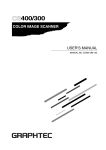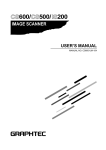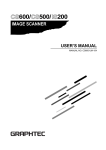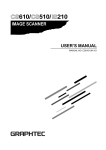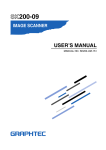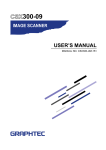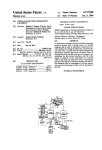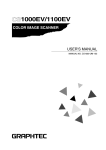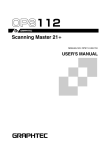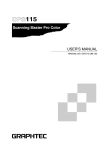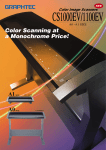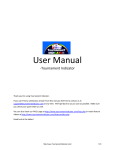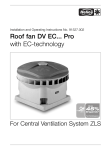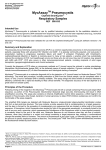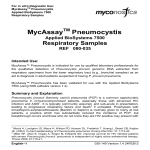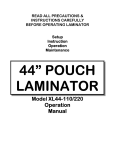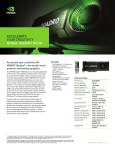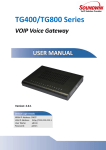Download Graphtec IS200 PRO & LC
Transcript
CS500/ IS200 IMAGE SCANNER USER’S MANUAL MANUAL NO. CS500-UM-151 TO ENSURE SAFE AND CORRECT USE • To ensure safe and correct use of your Image Scanner, read this Manual thoroughly before use. • After having read this Manual, keep it in a handy location for quick reference as needed. • Do not permit small children to touch the Image Scanner. • The following describes important points for safe operation. Please be sure to observe them strictly. Conventions Used in This Manual To promote safe and accurate use of the Image Scanner as well as to prevent human injury and property damage, safety precautions provided in this manual are ranked into the three categories described below. Be sure you understand the difference between each of the categories. DANGER : WARNING : This category provides information that, if ignored, is highly likely to cause fatal or serious injury to the operator. CAUTION : This category provides information that, if ignored, could cause injury to the operator or physical damage to the Image Scanner. This category provides information that, if ignored, is likely to cause fatal or serious injury to the operator. Description of Safety Symbols The symbol indicates information that requires careful attention (which includes warnings). The point requiring attention is described by an illustration or text within or next to the symbol. The symbol indicates action that is prohibited. Such prohibited action is described by an illustration or text within or next to the symbol. The symbol indicates imperative action (that must be performed). Such imsymbol. perative action is described by an illustration or text within or next to the –i– Safety Precautions WARNING Do not disassemble, repair, or remodel this scanner. • Such action may cause a fire hazard or electrical shock. • Such action could impair the scanner’s performance and cause it to malfunction or break down. If the scanner generates smoke, is abnormally hot, emits a strange odor, or otherwise functions abnormally, do not continue using it. Turn off its power and unplug its power cord from the electrical socket. • Use of the scanner in such status may result in a fire hazard or electrical shock. • Request repair by contacting your sales representative or nearest Graphtec vendor. • Never try to perform repair yourself. Repair work by inexperienced personnel is extremely dangerous. If the scanner is damaged from being dropped or other impact, turn off its power and unplug its power cord from the electrical socket. • Use of the scanner in such status may result in a fire hazard or electrical shock. • Request repair by contacting your sales representative or nearest Graphtec vendor. • Never try to perform repair yourself. Repair work by inexperienced personnel is extremely dangerous. If water or foreign matter enters the scanner, turn off its power and unplug its power cord from the electrical socket. • Use of the scanner in such status may result in a fire hazard or electrical shock. • Request repair by contacting your sales representative or nearest Graphtec vendor. • Never try to perform repair yourself. Repair work by inexperienced personnel is extremely dangerous. – ii – No disassembly Unplug the power cord from the socket Unplug the power cord from the socket Unplug the power cord from the socket Safety Precautions (Continued) WARNING Do not connect the scanner to a non-rated power supply. • Use of a different supply voltage may result in a fire hazard or electrical shock. Prohibited CAUTION Be sure to ground the earth terminal. • Unless the scanner is grounded, the operator could suffer an electrical shock in case of current leakage. Ground the scanner Insert the scanner’s power plug securely into the electrical socket. • After first connecting the power cord’s female plug to the scanner, connect its male plug to the electrical socket. • Using the scanner with its power plug incompletely inserted into the electrical socket could cause a fire hazard or electrical shock. Do not allow dust or metallic matter to adhere to the power cord’s plug. • If the power cord’s plugs become dirty, thoroughly wipe them clean. • The use of a dirty power cord plug could result in a fire hazard or electrical shock. Securely insert the power plug into the socket Prohibited Beware of electrical shock When the scanner will not be used for an extended period, unplug its power cord from the electrical socket. • Leaving the scanner connected to a power supply increases its risk of short-circuiting and overheating. Unplug the power cord from the socket – iii – Safety Precautions (Continued) CAUTION Be careful not to damage the power cord or the interface cable and never use a damaged cord or cable. • Do not use unnecessary force to bend, pull, twist, or bind the cord and cable, place a heavy object on them, nor remodel them. Such actions could result in scratches or damage to the cord or cable. • Use of a damaged power cord or interface cable may result in electrical shock or a fire hazard. • Replace the damaged cord or cable with a new one. When disconnecting the power cord or the interface cable, do not pull on the cord/cable. • Such action will damage the cord/cable, resulting in a fire hazard or electrical shock. Be sure to hold the power cord’s plug or the interface cable’s connector. Before disconnecting or reconnecting the power cord, be sure to turn off the scanner. • Failure to do so may damage the scanner’s performance and cause it to malfunction or break down. • Failure to do so may result in electrical shock. Never damage or use when damaged Pulling prohibited Turn off the Power switch Before cleaning the scanner, be sure to unplug its power cord from the electrical socket. • Failure to do so may result in electrical shock. Unplug the power cord from the socket Do not install, use, or store the scanner in a location exposed to direct sunlight and/or the direct draft of an air conditioner or heater. • Such location may impair the scanner’s performance due to deformation or other damage and cause the scanner to malfunction or break down. – iv – Prohibited Safety Precautions (Continued) CAUTION Do not install, use, or store the scanner in a location that does not meet the specified temperature and humidity ranges. • Such location may impair the scanner’s performance and cause the scanner to malfunction or break down. Prohibited Do not install, use, or store the scanner in a location subject to excessive mechanical vibration or electrical noise. • Such location may impair the scanner’s performance and cause the scanner to malfunction or break down. Prohibited Do not install the scanner on an unstable surface. • The scanner could break due to impact from falling from the surface or cause injury to the operator. Install on a level surface Prohibited While the scanner is operating (reading or ejecting a document), keep hands, clothing, and other objects away from the document. • Injury could result from an object getting tangled in the scanner’s rollers. Do not place any receptacle containing water or other fluid on top of the scanner. • Fluid falling inside the scanner may cause a fire hazard or electrical shock due to a short circuit or overheating. Keep away Avoid water areas Beware of electrical shock Do not place heavy objects on the scanner. • Such action may impair the scanner’s performance due to deformation or other damage, and cause the scanner to malfunction or break down. –v– Prohibited Safety Precautions (Continued) CAUTION Do not use sharp, pointed articles on the scanner. • Such action may impair the scanner’s performance and cause the scanner to malfunction or break down. Prohibited Do not exert pressure on the scanner. • Such action may impair the scanner’s performance and cause the scanner to malfunction or break down. • Such action could cause injury to the operator. Do not attempt to lubricate the scanner’s mechanisms. • Such action may impair the scanner’s performance and cause the scanner to malfunction or break down. • Such action may cause a fire hazard or electrical shock due to a short circuit or overheating. Do not clean the scanner using a volatile solvent such as thinner or benzine. • Such action may impair the scanner’s performance and cause the scanner to malfunction or break down. Clean off the scanner’s soiled areas using a soft cloth that has been moistened with water or a neutral detergent (diluted with water) and then firmly wrung out, then wipe the scanner using a dry cloth. For more details, see Chapter 5, “Daily Maintenance.” – vi – Prohibited Prohibited Prohibited INTRODUCTION Thank you for purchasing a CS500 Series/IS200 Series Image Scanner. The CS500 Series/ IS200 Series scanners are capable of performing high-speed scanning of documents ranging in size from ISO A4 to ANSI E. This User’s Manual describes how to operate the CS500 Series/IS200 Series scanners, and also includes usage precautions. Read the manual thoroughly prior to use in order to ensure a full understanding of the product’s features, and to ensure effective use. Keep the manual in a safe place where it can be accessed easily whenever necessary. Items in this manual marked are precautions to ensure safe use. Please be sure to observe them strictly. Notes Regarding This Manual • All rights reserved. No part of this publication may be reproduced, stored in a retrieval system, or transmitted, in any form or by any means, without the prior written permission of Graphtec Corporation. • The specifications and other information in this manual are subject to change without notice. • While every effort has been made to provide complete and accurate information, please contact your sales representative or nearest Graphtec vendor if you find any unclear or mistaken information or have other comments or suggestions. • Notwithstanding the stipulation in the preceding paragraph, Graphtec Corporation assumes no liability for damages resulting from either the use of the information contained herein or from use of the product. • All names of companies, brands, logotypes, and products appearing in this manual are the trademarks or registered trademarks of their respective companies. Trademarks Windows is a U.S. registered trademark of Microsoft Corp. Other product names mentioned herein are trademarks or registered trademarks of their respective owners. – vii – Usage precautions Side cover Do not lift or move the unit by holding the top cover, as doing so may damage the unit. Always lift the unit by holding the underside. Top cover Side cover Take care to prevent your fingers from being caught in the gap between the top cover and the scanner unit when opening and closing the top cover. Top cover Top cover < Opening the top cover > Do not hold the rear section of the top cover when opening it. < Closing the top cover > Keep your hands away from the front of the main unit when closing it. The above illustrations are of the CS500 model. Always ensure that you open the top cover and remove the cushion material before using the product. (Refer to Section 5.1, “Opening and Closing the Top Cover”.) Scanner Warm-up A warm-up period is not usually required for the CS500/IS200 Series scanners. However, if you plan to scan a color document (in particular a document with many light colors), we recommend that you allow the CS500/IS200 Series scanners to warm up for 10 minutes before scanning the document. – viii – Contents TO ENSURE SAFE AND CORRECT USE ..................................................... I Conventions Used in This Manual .................................................................................... i Description of Safety Symbols ......................................................................................... i Safety Precautions ............................................................................................................... iii INTRODUCTION .......................................................................................... VII 1. OVERVIEW ............................................................................................. 1-1 1.1 1.2 Features .................................................................................................................. 1-1 Unpacking the Scanner .......................................................................................... 1-2 2. PREPARATION ...................................................................................... 2-1 2.1 2.2 2.3 Assembling the Scanner ......................................................................................... 2-1 Part Names and Functions ..................................................................................... 2-7 Attaching the Document Support Wires ................................................................ 2-10 3. PREPARING TO OPERATE THE SCANNER ........................................ 3-1 3.1 3.2 3.3 3.4 3.5 3.6 3.7 System Requirements ............................................................................................ 3-1 Connecting the Scanner to a Power Supply ........................................................... 3-2 Connecting the Scanner to a Computer ................................................................. 3-5 Connecting the Scanner via an Ethernet Interface ................................................. 3-6 Installing the Driver Software ................................................................................ 3-14 Checking the Interface Connection ..................................................................... 3-19 Installing the Scanning Master 21+ Application .................................................... 3-21 4. LOADING A DOCUMENT ...................................................................... 4-1 4.1 4.2 4.3 4.4 4.5 Compatible Document Types .................................................................................. 4-1 Loading a Document ............................................................................................... 4-3 Handling Documents According to their Material and Thickness ............................ 4-5 Distance Correction ................................................................................................ 4-7 Using the Carrier Sheet .......................................................................................... 4-7 5. DAILY MAINTENANCE .......................................................................... 5-1 5.1 5.2 5.3 5.4 5.5 5.6 Opening and Closing the Top Cover ....................................................................... 5-1 Cleaning the Document Hold-Down Unit ................................................................ 5-3 Cleaning the Image Sensors .................................................................................. 5-3 Cleaning the Paper Sensors ................................................................................... 5-5 Removing a Jammed Document ............................................................................ 5-7 Calibration ............................................................................................................... 5-7 – ix – 6. TROUBLESHOOTING PROCEDURES ................................................. 6-1 6.1 6.2 6.3 6.4 6.5 6.6 6.7 6.8 6.9 6.10 6.11 6.12 6.13 6.14 6.15 6.16 6.17 The scanner is turned on but doesn’t operate at all ................................................ 6-1 The scanner operates improperly after connection to the computer ...................... 6-1 The control panel’s red Error lamp is lit .................................................................. 6-2 The control panel’s red Error lamp is flashing ......................................................... 6-2 The document isn’t properly fed to the initial scanning position ............................. 6-3 After scanning, image data becomes black or white .............................................. 6-3 The image quality has dropped .............................................................................. 6-3 The input image data is incorrectly aligned ............................................................ 6-5 Smudges not appearing in the original document appear in the scanned data ...... 6-7 The image-data color intensity differs ..................................................................... 6-7 The document length differs from the scanned data length .................................... 6-7 Stripes or moiré patterns which are not in the original document appear in the scanned data ............................................................................................... 6-7 After scanning, image quality drops ........................................................................ 6-7 After scanning, image data is patchy ...................................................................... 6-7 The document cannot be fed correctly ................................................................... 6-8 “Document size cannot be acquired” is displayed .................................................. 6-8 The document to be scanned is too short or too long in length .............................. 6-8 APPENDIX A. OPTIONAL AND MISCELLANEOUS ITEMS .................... A-1 APPENDIX B. STANDARD SPECIFICATIONS ........................................ B-1 APPENDIX C. EXTERNAL VIEW .............................................................. C-1 INDEX .................................................................................................... IDEX1 –x– 1. OVERVIEW 1. OVERVIEW 1.1 Features 600-dpi optical resolution for high-precision image scanning Scanning with an optical resolution of 600 dpi allows even complex and difficult-to-scan documents, such as CAD drawings, electronic files, and mapping data to be scanned rapidly and with high precision. Scanning Master 21+ (scanner software included as a standard accessory) can be used to adjust the resolution (50 dpi to 800 dpi [50 dpi to 4,800 dpi for the PRO Models] in 1-dpi increments) to suit the scanned document. Compatible document widths range from 210 mm to 1066 mm Compatible with document sizes from ISO A4 up to ANSI E Capable of color and grayscale scanning (grayscale only for the IS200 Series scanners) The CS500 Series scanners are capable of scanning in color (24-bit color, 8-bit color) or grayscale (256 shades). The IS200 Series scanners are capable of scanning in grayscale (256 shades). Capable of reading long-axis data Scanning of long-axis images is supported. Compact and lightweight design A compact design was achieved by using a document travel system that employs contact image sensors in the sensor unit (five rows arranged in a zigzag pattern). Image-processing functions Use of the scanning software provided lets you set image-processing functions for the scanning of a document. Interface USB 2.0, IEEE 1394: CS500-11/11PRO, IS200-11/11PRO Ethernet: CS500-11eN/11eN-PRO, IS200-11eN/11eN-PRO CS500/IS200 1–1 1. OVERVIEW 1.2 Unpacking the Scanner After unpacking the Image Scanner, check its outer casing and check that the standard accessories listed below are all present. If you detect a surface flaw or a missing accessory, please promptly contact your sales representative or nearest Graphtec vendor. Standard Accessories Power cable 1 User’s Manual 1 Software CD-ROM 1 Document support wires 3 Carrier sheet IS0907 1 Calibration/Color correction sheets 1 set • One Calibration sheet • One Color correction sheet Cleaning paper 1–2 1 pack CS500/IS200 2. PREPARATION 2. PREPARATION 2.1 Assembling the Scanner CS500 series Two persons are required for the assembly operation. Assemble the stand before mounting the scanner unit. (1) Assemble the caster frames and the side stays using the four screws provided. Caster frame Caster frame Side stay Side stay (2) Attach the center bar to the side stays temporarily using the four screws provided. Side stay Side stay Center bar Groove Caster Caster Attach the center bar loosely. Tighten the screws securely after the scanner unit has been mounted on the stand. CS500/IS200 2–1 2. PREPARATION (3) Hold the scanner unit by the underside at both sides as you adjust its position untilthe rubber feet on the underside of the scanner unit are aligned with the notches inthe side stays. Place the scanner unit on the stand so that the grooves in the center bar are facing the front, and then secure it in place using the four coin screws provided. Holding the scanner by the rear part of the top cover may cause damage to the scanner or injury to the persons doing the installation. Always hold the scanner by the underside. Side cover Side cover Rubber feet Fixing plate Fixing plate Coin screw Coin screw Notch Fixing plate Center bar Groove (4) 2–2 Secure the side stays in place by tightening up the four center bar fixing screws (see (2) above). CS500/IS200 2. PREPARATION (5) Attach the basket to the stand Position frames 1 and 2 so that they rest on screws A and are hooked onto screws B in order to attach the basket. Screw A Frame 1 Screw B Screw A Frame 2 Screw B Screw A Screw A Basket (6) Attach frame 3 to screws B below screws A and stretch out the basket cloth. Screw B Screw B Screw A Screw A Frame 3 (7) Always ensure that you remove the cushion material that is included below the document hold-down unit before using the product. (Refer to Section 5.1, “Opening and Closing the Top Cover”.) CS500/IS200 2–3 2. PREPARATION IS200 series Two persons are required for the assembly operation. Assemble the stand before mounting the scanner unit. (1) Assemble the caster frames and the side stays using the four screws provided. (It is not necessary to distinguish between the left side and the right side stay because both stays have the same shape.) Caster frame Caster frame Side stay Side stay (2) Attach the center bar to the side stays temporarily using the four screws provided. Side stay Side stay Center bar Groove Caster Caster Attach the center bar loosely. Tighten the screws securely after the scanner unit has been mounted on the stand. 2–4 CS500/IS200 2. PREPARATION (3) Hold the scanner unit by the underside at both sides as you adjust its position untilthe rubber feet on the underside of the scanner unit are aligned with the notches inthe side stays. Place the scanner unit on the stand so that the grooves in the center bar are facing the front, and then secure it in place using the four coin screws provided. Holding the scanner by the rear part of the top cover may cause damage to the scanner or injury to the persons doing the installation. Always hold the scanner by the underside.. Side cover Side cover Rubber feet Fixing plate Fixing plate Coin screw Coin screw Center bar Notch Fixing plate Groove (4) Secure the side stays in place by tightening up the four center bar fixing screws (see (2) above). CS500/IS200 2–5 2. PREPARATION (5) Attach the basket to the stand Position frames 1 and 2 so that they rest on screws A and are hooked onto screws B in order to attach the basket. Screw A Frame 1 Screw B Screw A Frame 2 Screw B Screw A Screw A Basket (6) Attach frame 3 to screws B below screws A and stretch out the basket cloth. Screw B Screw B Screw A Screw A Frame 3 (7) 2–6 Always ensure that you remove the cushion material that is included below the document hold-down unit before using the product. (Refer to Section 5.1, “Opening and Closing the Top Cover”.) CS500/IS200 2. PREPARATION 2.2 Part Names and Functions Front View Paper sensor Control panel Top cover Cover sensor Document guides Paper sensor Top cover Lock Stand Basket Caster Control panel Cover sensor Release Document guides CS500 Lock Basket Stand Release Caster IS200 Top cover Open the top cover to clean the document hold-down unit and transparent contact plates. Paper sensors These sense whether a document is present in the scanner. Cover sensor This senses whether the top cover is open or closed, and interrupts scanner operation if the top cover is opened during operation. Document guides Use these guides to determine the position of a document when you load the document. Control panel Use the keys to operate the scanner and the LEDs to monitor the operating status. Stand The stand unit is assembled for mounting of the scanner unit. Basket Receives the document that has been scanned. Casters Release the lock on the casters to allow the unit to be moved. Do not touch the paper sensors. CS500/IS200 2–7 2. PREPARATION Rear View Power switch IEEE 1394 connector AC line inlet USB connector CS500-11 CS500-11PRO IS200-11 IS200-11PRO Ethernet connector USB connector CS500-11eN CS500-11eN-PRO IS200-11eN IS200-11eN-PRO The above illustration is of the CS500 model. Power switch Controls the on/off status of the power supply to the scanner. AC line inlet Connect the power cord’s female plug here. USB connector Used to connect the USB interface cable. IEEE 1394 connector Used to connect the IEEE 1394 interface cable. Ethernet connector Used to connect the Ethernet cable. The USB and IEEE 1394 connectors cannot be used at the same time. Do not connect both the USB and IEEE 1394 cables to a computer, or to two separate computers, at the same time. 2–8 CS500/IS200 2. PREPARATION Control panel POWER PAPER ERROR SCAN POWER LED Unlit Lit (green) : Is unlit while the scanner is turned off. : Lights when the scanner is turned and remains lit while it is operating normally. Flashing (orange) : Flashes when the scanner is in power-saving mode. PAPER LED FORWARD REVERSE Unlit : Normal status (Local status). Lit (green) : Lights when the scanner enters Scan READY status. Flashing (green) : Flashes while image data is being scanned. ERROR LED Lit (red) Flashing (red) STOP Unlit : Lights to indicate a hardware error. : Flashes when a document is detected during the selftest when the scanner is turned on; when scanning is suspended by pressing the STOP key; when a paper jam is detected; or when the document length is shorter than the specified scan length.* : Normal status “Confirm” has been selected for the End-of-paper Processing setting ( * inWhen ) the Scanning Master 21+ driver. SCAN key This key enables you to scan a document according to the settings of Scanning Master 21+ when the scanner is connected to a computer. Start up Scanning Master 21+ before scanning a document if it is not already active. FORWARD key Advances the document into the scanner. When this key is pressed in Scan READY status, the Scan READY status is cancelled and the document is ejected toward the rear of the scanner. REVERSE key Feeds the document toward you. When this key is pressed in Scan READY status, the Scan READY status is cancelled and the document is ejected toward the front of the scanner. STOP key Compulsorily stops scanning of the document. CS500/IS200 2–9 2. PREPARATION 2.3 Attaching the Document Support Wires Always ensure that the document support wires are attached to the scanner unit before scanning a document. Note: Drawings of the CS500 model are used for the explanations. Document support wires The document may be damaged upon contact with the power cable if it is scanned without the document support wires in place. Attaching the document support wires (1) Insert one end of the document support wire provided into one of the smaller slots at the rear of the scanner. There is a second, hidden slot directly underneath each slot. Insert the end of the wire so that it fits into the hidden slot on the lower level. Document support wire end Hidden slot on the lower level 2 – 10 CS500/IS200 2. PREPARATION (2) Press the other end of the document support wire towards the end already inserted, and then insert it into the corresponding slot. As with the first end, insert the other end of the wire so that it fits into the hidden slot on the lower level. Document support wire end Hidden slot on the lower level (3) Insert the center part of the document support wire into the elongated slot. (4) Attach the other document support wires in the same manner. Detach the document support wires when moving or packing the scanner. Squeeze each wire gently towards the center and then lift it up to detach it. CS500/IS200 2 – 11 3. PREPARING TO OPERATE THE SCANNER 3. PREPARING TO OPERATE THE SCANNER 3.1 System Requirements The minimum system requirements for running the scanner’s hardware and software are listed below. Operating system: Windows 2000 Professional/XP Professional/XP Home Edition CPU: Pentium III/4 Memory: 32 MB or more Monitor: 1024 × 768 pixels, 256 colors or more Enough disk space to store data Mouse Interface: USB interface*1 that comes standard with your computer, IEEE 1394 interface*2, or Ethernet interface (10BASE-T/100-BASE-TX). *1 If your scanner does not operate with the USB interface that comes with your computer, or if your computer does not have a USB 2.0 interface, please contact your sales representative or nearest Graphtec vendor for information on supported add-on cards. *2 Graphtec does not guarantee correct scanner operation with every IEEE 1394 computer interface or add-on card. Please contact your sales representative or nearest Graphtec vendor for information on supported add-on cards. Recommended environment For binary monochrome data CPU: Pentium 4 Memory: 64 MB or more USB 2.0 interface (that comes standard with your computer) For grayscale data CPU: Pentium 4 Memory: 256 MB or more Monitor: 1024 × 768 pixels, High Color or higher resolution USB 2.0 interface (that comes standard with your computer) For 8-bit/24-bit color data (CS500 Series only) CPU: Pentium 4 Memory: 512 MB or more Monitor: 1024 × 768 pixels, True Color or higher USB 2.0 interface (that comes standard with your computer) The system configuration should correspond to the recommended specifications listed here, in order to ensure the optimum capabilities of the scanner. Use with a system configuration below the recommended specifications will affect the scanning speed and prevent the scanner from operating to its specified capabilities. To edit an A1-size or larger grayscale document with a resolution of 400 dpi or higher, or a color document, you may need more than the recommended memory sizes above. Depending on the type of document, you may not be able to scan in the document even if you increase the memory size. CS500/IS200 3–1 3. PREPARING TO OPERATE THE SCANNER 3.2 Connecting the Scanner to a Power Supply Note: Drawings of the CS500 model are used for the explanations. Connecting the Power Cable Insert the female plug of the power cord provided into the scanner’s AC line inlet and insert its male plug into an electrical socket supplying AC voltage. Check that the scanner’s Power switch remains in the Off position until the connection of both the power cord and the interface cable has been completed. Ensure that the scanner’s Power switch is in the Off position. Make sure that your scanner is properly grounded. If it is not grounded, there is a possibility that noise will cause incorrect operation, or that the scanned image may be distorted. 3–2 CS500/IS200 3. PREPARING TO OPERATE THE SCANNER Turning the Scanner On or Off Whenever the scanner’s Power switch is turned on, the POWER, PAPER, and ERROR lamps on the control panel light up. When the scanner has been initialized, the POWER lamp lights up. When resetting the scanner by turning it off then back on again, wait at least five seconds before turning it back on. CS500/IS200 3–3 3. PREPARING TO OPERATE THE SCANNER 3.3 Connecting the Scanner to a Computer Note: Drawings of the CS500 model are used for the explanations. The scanner can be connected to a computer using the USB interface or IEEE 1394 interface. (eN models are connected using the Ethernet interface). The operation of the scanner cannot be guaranteed in the following cases: • When the cable is connected to a USB hub or an add-on USB board. • When you are using a custom-built computer or one that you have modified. The following should never be attempted: • Remove or reinsert the cable while you are installing the driver. • Remove or reinsert the cable while starting up the computer or the scanner. • Remove or reinsert the cable within a period of 5 seconds. • Remove or reinsert the cable while transferring data. • Connect two or more scanners to a single computer. The USB and IEEE 1394 connectors cannot be used at the same time. Do not connect both the USB and IEEE 1394 cables to a computer, or to two separate computers, at the same time. Connecting the scanner via a USB 2.0 interface (1) Ensure that you have a USB 2.0 interface cable that works with your computer. Plug the USB 2.0 interface cable into the USB connector socket situated on the right-hand side of the scanner unit. USB connector To the computer USB 2.0 interface cable 3–4 CS500/IS200 3. PREPARING TO OPERATE THE SCANNER Connecting the scanner via an IEEE 1394 interface (1) Ensure that you have an IEEE 1394 interface cable that works with your computer. Plug the IEEE 1394 interface cable (6-pin) into the IEEE 1394 connector socket situated on the right-hand side of the scanner unit. IEEE 1394 connector To the computer IEEE 1394 (6-pin) connector IEEE 1394 interface cable Connecting the scanner via an Ethernet interface (1) Ensure that you have an Ethernet cable that works with your computer. Plug the Ethernet cable into the Ethernet connector located on the right-hand side of the scanner unit. Ethernet connector To the computer Ethernet interface cable CS500/IS200 3–5 3. PREPARING TO OPERATE THE SCANNER 3.4 Connecting the Scanner via an Ethernet Interface The procedure outlined below is based on the requirement that you are logged on to Windows with administrator rights. Consult your Windows 2000 or Windows XP manual or Windows Help for more information. Installing the Network Utility The following procedure assumes that you are using the CS500-11eN connected via the Ethernet interface as part of your system. The windows shown are those for Windows 2000. (1) (2) Connect the scanner to the computer, and turn on the computer’s power. Insert the CD-ROM disk (included with your computer) into the CD-ROM drive of the computer after Windows has started up, and then turn on the scanner’s power. When English\Network\Autorun.exe is executed, the following window appears. (3) Click [Setup]. 3–6 CS500/IS200 3. PREPARING TO OPERATE THE SCANNER (4) Click [Device Setup]. The following window appears. (5) Click [Next] to proceed (6) The “Software License Agreement” window appears. Carefully read the provisions of the agreement. Click [Yes] to continue with installation. The following window appears. (7) Specify the scanner’s IP address. Click [Search] and select the scanner. Note: If the IP address wasn’t found during the initial setting procedure, there is a possibility that there are two or more addresses with the factory setting (192.168.1.1) on the network. CS500/IS200 3–7 3. PREPARING TO OPERATE THE SCANNER (8) Click [Next] to display the following window.. For automatic setup (when connected to the DHCP server) Select “Get IP address automatically”, and then click the [Next] button. For manual setup Select “Assign IP address”, specify your desired IP address, and then click [Next] Please contact your network administrator if you do not know your IP address. Two or more identical IP addresses may cause network problems. 3–8 CS500/IS200 3. PREPARING TO OPERATE THE SCANNER (9) Confirm the settings, and then click the [Execute]. (10) This completes the Device Setup operation. Installing the Graphtec Network Utility (11) Proceed to install the Graphtec Network Utility. Select [Yes], and then click [Finish]. (12) Click [Next]. (13) The “Software License Agreement” window appears. Carefully read the provisions of the agreement. CS500/IS200 3–9 3. PREPARING TO OPERATE THE SCANNER (14) Click [Yes] to continue with installation. The following window appears. Select the destination folder for installation. To specify a folder, click [Reference] and then select a folder, The default destination folder is C:\Program Files\Graphtec\Graphtec Network Utility. (15) Click [Next]. Specify the program folder name. (16) Click [Next]. 3 – 10 CS500/IS200 3. PREPARING TO OPERATE THE SCANNER (17) Click [Start] to start the installation procedure. (18) When installation has been completed, click [Finish]. CS500/IS200 3 – 11 3. PREPARING TO OPERATE THE SCANNER Setting up the Graphtec Network Utility (1) Set up the Graphtec Network Utility. Launch the utility from the Graphtec Network Utility created in the Program folder. (2) (2) Register the destination server. When the Utility is launched, the server registration window appears. In the Graphtec Network Utility, server refers to the scanner. (3) Click [Yes] to perform registration of the server. Note: Even if [No] is selected, you can still proceed to the registration window by clicking When entering the IP address, enter both the [IP address] and the [Server Name]. Click [Search] to search for the destination server. 3 – 12 CS500/IS200 3. PREPARING TO OPERATE THE SCANNER Select the connected server, and then click [OK]. (4) Click [Register] to connect from the Utility. (5) Click [Connect]. (6) After connecting with the Utility, specify the CS500-11eN/11eN-PRO or the IS200-11eN/ 11eN-PRO driver as appropriate, and perform installation. For further details on the installation procedure, refer to Section 3.5, “Installing the Driver Software”. When using a CS500-11eN/11eN-PRO or the IS200-11eN/11eN-PRO connected to an Ethernet interface, be sure to launch the Graphtec Network Utility and click the [Connect] button. Furthermore, when you have finished using the scanner, click the [Disconnect] button to put the scanner in a status that enables it to be used with other computers. If the [Connect] button is displayed in gray, the scanner is being used with another computer. Please connect the scanner when the [Connect] button display returns to black. CS500/IS200 3 – 13 3. PREPARING TO OPERATE THE SCANNER 3.5 Installing the Driver Software The procedure outlined below is based on the requirement that you are logged on to Windows with administrator rights. Consult your Windows 2000 or Windows XP manual for more information. For Windows 2000 The following procedure assumes that you are using the CS500-11 as part of your system, and that you are using the USB interface. If you are using the IEEE 1394 interface, GRAPHTEC CS500-11 IEEE 1394 SBP2 Device will be displayed where CS500-11 is displayed when the USB interface is used. The scanner name displayed in the windows is the name of the scanner connected to the computer (CS500-11 is used in this section). (1) (2) 3 – 14 Connect the scanner to the computer, and turn on the computer’s power. Insert the CD-ROM disk (included with your computer) into the CD-ROM drive of the computer after Windows has started up, and then turn on the scanner’s power. [Next], the Found New Hardware Wizard appears. CS500/IS200 3. PREPARING TO OPERATE THE SCANNER (3) Click the [Next] button to proceed to the menu for installing the driver. (4) Select the option “Search for a suitable driver for my device (recommended)” and click [Next] . (5) Select the check box entitled “Specify a location” and click Next. Click [Browse] and select the DRIVER folder in the CD-ROM drive or enter a CDROM drive name and \DRIVER using the keyboard. Example: For drive E, enter “E:\DRIVER.” CS500/IS200 3 – 15 3. PREPARING TO OPERATE THE SCANNER (6) When you click [OK] the wizard will start searching for the driver. The screen shown below is displayed when the wizard has finished searching. (7) The screen shown below is displayed when you click [Next] . Click [Yes] to continue the installation. (8) The screen shown below is displayed when the wizard has finished installing the driver. Click the [Finish] button. (9) 3 – 16 The Windows 2000 desktop appears, and the scanner is recognized by the computer. CS500/IS200 3. PREPARING TO OPERATE THE SCANNER For Windows XP The following procedure assumes that you are using the CS500-11 as part of your system, and that you are using the USB interface. If you are using the IEEE 1394 interface, GRAPHTEC CS500-11 IEEE 1394 SBP2 Device will be displayed where CS500-11 is displayed when the USB interface is used. The scanner name displayed in the windows is the name of the scanner connected to the computer (CS500-11 is used in this section). (1) (2) Connect the scanner to the computer, turn on the scanner first, and then turn on the computer. When Windows starts up, insert the CD-ROM supplied with the scanner in the CD-ROM drive. Turn on the power to the scanner. [Next], the Found New Hardware Wizard window appears. Select the option “Install from a list or a specific location (Advanced)”. (3) The screen shown below is displayed when you click [Next]. Select the option “Search for the best driver in these locations” and select the check box entitled “Include this location in the search”. Click Browse and select the DRIVER folder in the CD-ROM drive or enter a CD-ROM drive name and \DRIVER using the keyboard. Example: For drive E, enter “E:\DRIVER.” CS500/IS200 3 – 17 3. PREPARING TO OPERATE THE SCANNER (4) When you click [Next] the wizard will start searching for the driver. (5) The screen shown below is displayed. Click [Continue Anyway] to continue the installation. (6) The screen shown below is displayed when the wizard has finished installing the driver. Click the [Finish] button to close the “Welcome to the Found New Hardware” wizard. (7) 3 – 18 The Windows XP desktop appears, and the scanner is recognized by the computer. CS500/IS200 3. PREPARING TO OPERATE THE SCANNER 3.6 Checking the Interface Connection For Windows 2000 The procedure outlined below assumes that the CS500-11 is connected in your system. The scanner name displayed in the windows is the name of the scanner connected to the computer (CS500-11 is used in this section). (1) Launch the Control Panel using the Start menu. (2) The screen shown below is displayed when you click on the “Scanners and Cameras” icon. Check that “Graphtec CS500-11” is displayed here. CS500/IS200 3 – 19 3. PREPARING TO OPERATE THE SCANNER For Windows XP The procedure outlined below assumes that the CS500-11 is connected in your system. The scanner name displayed in the windows is the name of the scanner connected to the computer (CS500-11 is used in this section). (1) (2) Launch the Control Panel using the Start menu. The screen shown below is displayed when you click on the “Printers and Other Hardware” icon. (3) The screen shown below is displayed when you click on the “Scanners and Cameras” icon. Check that “Graphtec CS500-11” is displayed here. 3 – 20 CS500/IS200 3. PREPARING TO OPERATE THE SCANNER 3.7 Installing the Scanning Master 21+ Application The Scanning Master 21+ “OPS112” is a software application for using a Graphtec scanner to scan image data. Operating Environment Windows 2000 Professional/XP Professional/XP Home Edition Installation Procedure (The following steps are explained using the Windows 2000.) (1) Boot Windows 2000. (2) Insert the User Guide CD-ROM containing the OPS112 program files into the computer’s CD-ROM drive. (3) Click the Taskbar’s Start button, then click the Run... icon. (4) Enter the CD-ROM drive name and English\OPS112\SETUP.EXE as the name of the file you wish to open. If the disk is in drive E, for example, enter “E:\English\OPS112\SETUP.EXE” in the box. (5) Click the OK button to run the OPS112 setup program. From this point on, follow the setup program’s instructions to install the OPS112 application. • If the application has been properly installed, “Scanning Master 21+” will be newly listed in the Program menu accessed from the Start button. For more details, open the README.TXT file provided in the “Scanning Master 21+” folder. CS500/IS200 3 – 21 4. LOADING A DOCUMENT 4. LOADING A DOCUMENT This chapter describes the document types compatible with your scanner and procedures related to loading a document. 4.1 Compatible Document Types Because the scanner scans a document while feeding it, the document types that it can scan are subject to the following restrictions. Compatible Media Widths for Scanning Documents with a maximum width of 1066 mm Size ISO Size ANSI A4 210 mm × 297 mm A 8.5 in × 11 in A3 297 mm × 420 mm B 11 in × 17 in A2 420 mm × 594 mm C 17 in × 22 in A1 594 mm × 841 mm D 22 in × 34 in A0 841 mm × 1189 mm E 34 in × 44 in Compatible Media Lengths for Scanning Documents up to approximately 16 m in length (driver software limitation) can be scanned. However, the actual document length that can be scanned is limited by the available memory (hard disk or other data storage device) of the computer to which the scanner is connected, and also by the grade of the medium being scanned. Compatible Grades & Thickness for Scanning Media Grades The scanning precision is guaranteed for high-grade tracing paper (see APPENDIX B, “SPECIFICATIONS”). Other compatible media types are listed below. High-grade paper : 60 g/m2 Tracing paper : 50 to 55 g/m2 Mylar : 50 µm Copy paper Diazo photo-sensitive paper Media Thicknesses Observe the following points when scanning a thick medium. • The CS500/IS200 seris scanners cannot scan a document that is thicker than 1.5 mm. • When using the carrier sheet, ensure that the combined thickness of both the document and carrier sheet does not exceed 1.5 mm. • The carrier sheet alone is 0.2 mm thick. CS500/IS200 4–1 4. LOADING A DOCUMENT Regarding the automatic detection of the paper size This scanner supports the automatic detection of the document size by determining where the edges of the document are. The edges of the document cannot, however, always be detected correctly, especially if the document is thin. The scanner also assumes that the document is set in the center when it determines the document size. The correct document size cannot be detected when a carrier sheet is used because the carrier sheet is detected instead. The document size may not be detected correctly if the document hold-down unit or transparent contact plates are dirty. Please clean the document hold-down unit and transparent contact plates in such cases. When automatic detection is selected for the document size Automatic detection The document is scanned to automatically detect width and length. Automatic detection of standard size The document is scanned in the standard paper size determined from the automatically detected document width. Automatic detection—ISO series Automatic detection—ANSI series Automatic detection—ARCH series Automatic detection—DIN series The document is scanned in the paper size of the respective series as determined from the automatically detected document width. 4–2 CS500/IS200 4. LOADING A DOCUMENT 4.2 Loading a Document Insert the document onto the document-scanning table face down so that it presses against the rollers evenly. How to use the document guides • Move the document guides to the left and right until they are adjusted to the document width. • Place the document between the document guides. • Move the document guides back to the edges of the scanner after you have loaded the document. • This ensures that the document does not get damaged if it is fed at an angle. Document guides Document-scanning table The above illustration is of the CS500 model. CS500/IS200 4–3 4. LOADING A DOCUMENT POWER PAPER ERROR SCAN FORWARD There are two document setting modes available (set by the driver software). • The rollers start turning at a preset delay time after the document has been inserted so that they automatically feed the document to the position to start scanning. • The rollers start turning when the FORWARD switch on the control panel is pressed after a document is inserted so that they automatically feed the document to the position to start scanning. (Manual loading) Press the REVERSE switch to eject the document in order to reload it. The PAPER LED lights up when a document is correctly loaded. REVERSE STOP If the PAPER LED does not light after the document feed operation has stopped, press the FORWARD key to advance the document again. • After the scanner is turned on and the driver settings have been enabled in the Scan window, it waits for approximately three seconds before beginning the specified scan operation. • Load the document in the scanner with the face to be scanned facing downward. • Do not place anything other than the document to be scanned on the scanning table, as the scanner rollers may start rotating, which is extremely dangerous. • The document may not be fed in correctly if it is curled. The carrier sheet provided should be used for curled documents (see Section 4.6, “Using the Carrier Sheet” for details). • Load the document in the center of the scanner, as the document may be fed in at an angle and not scanned correctly if it is significantly off-center. 4–4 CS500/IS200 4. LOADING A DOCUMENT 4.3 Handling Documents According to their Material and Thickness The following problems may occur, depending on the weight and surface condition of the document being scanned. • • • • The document cannot be loaded. Scanning of the document stops half way through. The document slips (resulting in displaced images). The end of the document is not scanned. Such problems may be avoided by taking the following corrective measures. • Lower the scanning speed. • Support the document at the front and the back of the scanner. CS500/IS200 4–5 4. LOADING A DOCUMENT 4.4 Distance Correction Corrections to the distance can be achieved using the driver software. The driver software included with your scanner (“Scanning Master 21+”) enables you to perform distance correction from the menu Tool → Adjust Scanner in order to adjust the scanning accuracy. The adjustment function must be set up when a scanned drawing needs to approximate the accuracy of the original drawing closely. (This is for making fine adjustments to the accuracy of the scanned drawing to suit the quality of the paper being used.) It is not normally necessary to perform this adjustment. Adjustment method Perform the distance correction process according to the type of document to be scanned. Distance correction can be set in a range of ±1%, which remains effective until the scanner’s power is turned off. The practice of distance correction necessitates that you measure a vertical line drawn on the document before following the procedure described below. (1) (2) (3) (4) (5) (6) 4–6 Choose a document that has one or more vertical lines drawn on it and scan it at a resolution of 600 dpi (Portrait (vertical) format). Measure the length of the vertical line of the document and classify it as x (distance on the document). Measure the length of the same vertical line in the image data using the command to measure the distance between two specified points of relative measurement, and classify it as y (distance after the scan has taken place). Click on the Distance Correction button in the Adjust Scanner window to open the Distance Correction window. Enter the value “x” (distance on the document) and the value “y” (distance after the scan has taken place) in this window. The values entered here must be within the range of the distance correction. Click the OK button to calculate the correction value. The distance will be corrected the next time a document is scanned. CS500/IS200 4. LOADING A DOCUMENT 4.5 Using the Carrier Sheet Use the carrier sheet according to the condition of the document to be scanned. In the case of scanning the following types of media, always place the document in the carrier sheet before loading it into the scanner. • • • • To scan a medium that is as limp or limper than a newspaper To scan a document that is smaller than A4 size or a document of non-standard size To scan a medium that tears easily When the target document cannot be properly advanced to the initial position of scanning (because the target document is folded, wrinkled, or otherwise hard to load in the scanner) • To scan transparent or translucent documents • To scan a curled medium As shown in the figure below, place the document in the carrier sheet with the document’s surface to be scanned facing up (against the transparent top sheet). For scanning, load the carrier sheet into the scanner with the document’s target surface (the transparent top sheet) facing down. If you use the carrier sheet when scanning color documents, the colors may shift slightly in some cases. t in Inser ection r i d this Transparent sheet (front surface) Target document (the surface to be scanned faces up) White surface (background surface) The above illustration is of the CS500 model. When handling the carrier sheet, be very careful not to scratch it or otherwise damage it. CS500/IS200 4–7 5. DAILY MAINTENANCE 5. DAILY MAINTENANCE 5.1 Opening and Closing the Top Cover (1) Turn off the scanner’s power. (2) Push the left and right open levers on the top cover to unlock them, and hold the middle part of the top cover while you open the top cover by about 90 degrees. Open levers Top cover The above illustration is of the CS500 model. (3) Close the top cover until the left and right latches on the top cover lock into position, making sure that you don’t get your fingers caught. CS500/IS200 5–1 5. DAILY MAINTENANCE 5.2 Cleaning the Document Hold-Down Unit (1) Turn off the scanner. (2) Open the top cover as described in Section 5.1 “Opening and Closing the Top Cover”. Document hold-down unit Latch Latch The above illustration is of the CS500 model. (3) Wipe clean the underside of the document hold-down unit (see below) using a soft cloth that has been soaked in water or diluted neutral detergent and thoroughly wrung out. (4) Wipe the document hold-down unit once again using a soft, dry cloth (remove all moisture). (5) Close the top cover as described in Section 5.1 “Opening and Closing the Top Cover”. Take care not to get your fingers caught in the cover. Scanning may be affected if the underside of the document hold-down unit becomes scratched or dirty. It must be cleaned when necessary. 5–2 CS500/IS200 5. DAILY MAINTENANCE 5.3 Cleaning the Image Sensors The scanner’s image quality drops when the transparent contact plates over the image sensors become dirty, so clean the image sensors whenever necessary. Procedure (1) Turn off the scanner. (2) Open the top cover as described in Section 5.1 “Opening and Closing the Top Cover”. (3) As shown below, wipe off any soiled areas on the transparent contact plates using a soft cloth that has been moistened with water or a neutral detergent (diluted with water) and firmly wrung out. Transparent contact plates The above illustration is of the CS500 model. (4) Completely remove any moisture on the transparent contact plates by wiping them off again using a soft, dry cloth. (5) Close the top cover as described in Section 5.1 “Opening and Closing the Top Cover”. Take care not to get your fingers caught in the cover. Do not use a commercial cleaner for office equipment, a glass cleaner, or chemical solvents such as solutions containing alcohol. CS500/IS200 5–3 5. DAILY MAINTENANCE Although the transparent contact plate is not a maintenance part that requires periodic replacement, it is a consumable part because its surface may receive slight scratches due to minute particles of dust and other foreign matter. If document scanning produces unsatisfactory results (unexpected white or black streaks in the data) due to scratches on the transparent contact plate or other reasons, please perform the calibration procedure (see Section 5.6, “Calibration”). If the scanning results do not improve after calibration, the transparent contact plate(s) will need to be replaced. 5–4 CS500/IS200 5. DAILY MAINTENANCE 5.4 Cleaning the Paper Sensors Accumulated dust on the paper sensors may prevent the document from being detected. The sensors must be cleaned when necessary. (1) Turn off the scanner. (2) Open the top cover as described in Section 5.1 “Opening and Closing the Top Cover”. (3) Wipe the two paper sensors using a cotton swab. Paper sensors The above illustration is of the CS500 model. (4) Close the top cover as described in Section 5.1 “Opening and Closing the Top Cover”. Take care not to get your fingers caught in the cover. Use a cotton swab or something equally soft to gently wipe the paper sensors. Do not use any chemicals to clean the sensors. CS500/IS200 5–5 5. DAILY MAINTENANCE 5.5 Removing a Jammed Document If a document becomes jammed in the scanner during scanning or another operation, immediately turn off the scanner, remove the document hold-down unit, and then remove the jammed document. Procedure (1) Turn off the scanner. (2) Open the top cover as described in Section 5.1 “Opening and Closing the Top Cover”. (3) If the document is jammed at the front, remove the document from the inside or by pulling it forward. The above illustration is of the CS500 model. (4) If the document is jammed at the rear, remove the document from the inside by pulling it toward the rear. The above illustration is of the CS500 model. (5) 5–6 Close the top cover as described in Section 5.1 “Opening and Closing the Top Cover”. Take care not to get your fingers caught in the cover. CS500/IS200 5. DAILY MAINTENANCE 5.6 Calibration Calibrate the scanner if scanning quality is observed to deteriorate, with scanned results such as those described below: The scanned image is distorted Areas of uneven color appear in the scanned image Other unsatisfactory results (but not including problems related to media quality, such as folds, wrinkling, or paper curling) • Handle the calibration sheet with care so that it does not get bent. To prevent soiling, store it in its special storage box. The calibration sheet cannot be used if it is bent or soiled. • The calibration sheet is a paper product. Do not attempt to clean it with any type of liquid cleaner. • The calibration sheet is a consumable item. Replacement sheets can be purchased from your sales representative or nearest Graphtec vendor. Preparation and checks Recommended usage environment Monitor: 1024 × 768 pixels, High Color or better resolution A low-resolution monitor will make it difficult to discern any problem areas. Launching the Scanner Adjustment Program (1) Connect the scanner to the PC and switch on the scanner. Switch on the PC. (2) Install Scanning Master 21+ (OPS112) if it is not already installed. (3) Click the Start button, then select Programs > Scanning Master 21+ > Scanner Adjustment. (4) Click Scanner Adjustment to launch the Scanner Adjustment program. CS500/IS200 5–7 5. DAILY MAINTENANCE Scanner Calibration Before beginning calibration, clean the transparent contact plates and scanner table surface. Any dust or dirt on this surface may affect calibration results and resulting image quality. Check that the calibration sheet is free of any dust or dirt. The calibration procedure will take some time. Do not switch off the scanner while calibration is underway. Accidentally switching off the scanner may result in damage that requires servicing. (1) Connect the scanner to the computer. Switch on the scanner, then switch on the PC. (2) Launch the Scanner Adjustment program (as described earlier). (3) Select Model Setup on the Scanner menu. (4) Select the connected scanner and click the [OK] button. (5) Select Calibration on the Scanner menu. (6) Select All in Calibration and click the [Execute] button. (7) The following message is displayed. Insert the calibration sheet into the scanner as instructed. 5–8 CS500/IS200 5. DAILY MAINTENANCE (8) Clicking the [OK] button begins calibration. (9) Calibration ends after approximately 10 minutes. Click the [OK] button to complete calibration. (10) To check the calibration results, click the Confirm button in the Calibration menu (shown in step (5) above). (11) The following message is displayed. Insert the calibration sheet into the scanner as instructed. (12) Click the [OK] button to start scanning. The scanned data is displayed when scanning is complete. Colors may differ slightly for individual sensors to make it easier to identify problem areas in calibration. This does not indicate a defect. Check that there are no vertical streaks, such as white patches, in the scanned data. (Streaks occur when calibration is not performed correctly due to contamination by dust or dirt.) (13) If the data is normal, calibration is complete. Click the Close button and exit the Scanner Adjustment Program. CS500/IS200 5–9 5. DAILY MAINTENANCE (14) If any abnormal data is observed, specify the problem areas as follows: Select Specified Part in Calibration. (15) The mouse arrow cursor changes to a cross cursor when moved over the data. Click the left mouse button with the mouse positioned over the streak data. The selected area is shown in blue. Repeat this procedure for any additional streaks. Areas that have been selected (shown in blue) can be deselected by clicking the left mouse button again. To deselect all selected areas, click the Clear button. (16) Once all required areas have been specified, remove the calibration sheet and clean the glass and table surfaces. Check the calibration sheet for dust and dirt, then click the [Execute] button. (17) Return to step (10) and verify the calibration results. If you perform the calibration procedure several times with no discernible results, there may be a problem with the scanner itself. In this case, please contact your Graphtec vendor. Color Correction Perform color correction if there is any discrepancy in color in parts of the scanned image even after you have calibrated the scanner. Handle the color correction sheet with care so that it is does not get soiled, bent or scratched. A soiled, bent, or scratched sheet will not give good results. The color correction sheet is a consumable item, and replacement sheets can be purchased from your sales representative or nearest Graphtec vendor. 5 – 10 CS500/IS200 5. DAILY MAINTENANCE (1) Select Color Correction on the Scanner menu. (2) Click the Scan button. (3) The following message is displayed. Insert the color correction sheet in the scanner. Position the color correction sheet so that the red bar in the center of the sheet is centered in the scanner (but with the printed side down). (4) Click the [OK] button to start scanning. The scanned data is displayed when scanning is complete. Colors may differ slightly for individual sensors, but this does not indicate a defect. (5) When the data is displayed, click the Get button. (6) Click in the center of the color tile indicated by the numbers 1 to 6, in ascending order. Align the cursor crosshairs with the printed lines at the sides of the tile. Cursor lines (red) Align with the printed lines, then click. CS500/IS200 5 – 11 5. DAILY MAINTENANCE • The next reference point to be checked is displayed on the Status bar. • If you click in error, click the Esc. key to cancel the operation and return to the immediately previous step. • If you click on the wrong tile, color correction will not be performed correctly and the colors of the image displayed after color correction will be incorrect. (7) After you have clicked tile number 6, click the Set button. Click the [OK] button. (8) To check the color correction results, click the Confirm button. (9) The following message is displayed. Insert the color correction sheet in the scanner as instructed. Position the color correction sheet so that the red bar in the center of the sheet is centered in the scanner (but with the printed side down). (10) Click the [OK] button to start scanning. After scanning has been completed, an enlarged view of the color-corrected data is displayed. (11) Click the Fit icon to display the entire image, and check whether there is any discrepancy in color. If there is no discrepancy, color correction is complete. Click the Close button. If there is still some color discrepancy after performing Color Correction, repeat steps (6) through (11). 5 – 12 CS500/IS200 6. TROUBLESHOOTING PROCEDURES 6. TROUBLESHOOTING PROCEDURES If the scanner seems to be operating abnormally, perform the troubleshooting procedures described in this chapter before requesting a service call. 6.1 The scanner is turned on but doesn’t operate at all Cause The power cord has come loose. The scanner is connected to an electrical socket that does not provide the rated supply voltage. The electrical socket is not supplying a supply voltage. Remedy Firmly connect both plugs of the power cord. Use only the rated supply voltage. Check the power supply. 6.2 The scanner operates improperly after connection to the computer Cause Is the scanner properly grounded? Is the USB or IEEE 1394 cable between the computer and the scanner working properly? Is the USB cable compliant with the USB 2.0 interface that you are running? Is an add-on USB card being used? Remedy Make sure that the scanner is grounded. Determine whether the cable connector has any problems (e.g., a pin is broken or bent) and ensure that the cable is inserted firmly into position. Ensure that you use a USB 2.0-compliant USB cable. USB 1.1 cards are not supported. Correct operation is not guaranteed when the scanner is connected to a USB port that is not the standard built-in computer port. Are both the USB and IEEE 1394 cables connected? Both cables cannot be connected at the same time. Disconnect one of the cables. Are both the USB and Ethernet cables connected? Is the Graphtec Network Utility connected? (when using the Ethernet connection) Is the Graphtec Network Utility installed? (when using the Ethernet connection) Both cables cannot be connected at the same time. Disconnect one of the cables. Connect the Graphtec Network Utility. CS500/IS200 Install the Graphtec Network Utility. 6–1 6. TROUBLESHOOTING PROCEDURES The scanner is recognized as connected by the operating system (in the Device Manager), but the message “Scanner not found” is displayed in Scanning Master 21+ and the scanner cannot be connected. Cause Remedy The “Model Setup” settings are not correctly set in Scanning Master 21+. Set the “Model Setup” settings in Scanning Master 21+ to “CS500 series or IS200 series.” For details, refer to the Scanning Master 21+ User’s manual. Is the “Connection Method” of the Scanning Master 21+ correctly set? Ensure that the “Connection Method” of the Scanning Master 21+ is set to “USB” when you are using a USB interface. Consult the Scanning Master 21+ user’s manual for further information. 6.3 The control panel’s red Error lamp is lit Cause A hardware error at the ROM, RAM, etc. occurred during the scanner’s self-test. Remedy An internal error has occurred. Contact your sales representative or nearest Graphtec vendor. 6.4 The control panel’s red Error lamp is flashing Cause Remedy The scanner was turned on with a document left loaded inside it. Open the cover and remove the document (see Section 5.5, “Removing a Jammed Document”). The top cover was opened during a scanning operation or while a document was left in the scanner. Press the control panel’s STOP button to cancel the error state. Next, remove the document by pressing the FORWARD/REVERSE button to advance the document. If the document becomes jammed. Open the cover and remove the document. Refer to Section 5.5, “Removing a Jammed Document.” The document length setting made in Scanning Master 21+ is longer than the length of the actual document. The scanner’s Error lamp flashes when the end of the document is reached, but this does not indicate a problem with the scanner itself. Follow the Scanning Master instructions. 6–2 CS500/IS200 6. TROUBLESHOOTING PROCEDURES 6.5 The document isn’t properly fed to the initial scanning position Cause Remedy The target document is curled up, wrinkled, too thin, or otherwise poorly suited to proper feeding. Load the document after placing it inside the carrier sheet provided (see Section 4.6, “Using the Carrier Sheet”). Dust has accumulated on the paper sensors. Clean the paper sensors (see Section 5.4, “Cleaning the Paper Sensors”). The document to be scanned may be too thick or heavy. In such cases, you should support the document with your hand when you insert it into the scanner, or try lowering the scanning speed, or both. 6.6 After scanning, image data becomes black or white Cause Remedy The document was loaded with its target surface facing up instead of down. Load it in the scanner with its target surface (the surface to be scanned) facing down. The scanning conditions set were inappropriate for the document. Set the scanning conditions again (they can be controlled from the scanning software provided). 6.7 The image quality has dropped Cause Remedy The transparent contact plates over the image sensors are dirty Clean the transparent contact plates (see Section 5.3, “Cleaning the Image Sensors”) The carrier sheet is not used with transparent or translucent documents. Use the carrier sheet. CS500/IS200 6–3 6. TROUBLESHOOTING PROCEDURES 6.8 The input image data is incorrectly aligned Cause Remedy The data is misaligned at a joint between the image sensors. (see the figure on page 6-5) After opening the Tools menu of the driver program (Scanning Master 21+ driver) provided with your scanner, select the Joint Adjustment function then perform adjustment to achieve a seamless image. Your scanner comes shipped from the factory after being adjusted for high precision. Due to its operating environment or other factors, however, the scanning precision may deviate in very rare cases. Moreover, fine adjustment to correct such deviation can be performed using the driver software if the deviation causes are overlapped or missing data. Overlapped data Original document Data overlaps Original document Data is missing Missing data Deviation due to scanner specifications Original document 6–4 Deviation caused by specifications CS500/IS200 Joint between Joint between Joint between Joint between sensors 4 & 5 sensors 3 & 4 sensors 2 & 3 sensors 1 & 2 Sensor 5 Sensor 3 Sensor 1 Image sensor position Sensor 4 Markings on the document scanning table A2 Sensor 2 8.5 8.5 Control panel side 6. TROUBLESHOOTING PROCEDURES A2 Document feed direction Because the document is loaded face down, Sensor 1 is the leftmost sensor in the driver software’s display windows. CS500/IS200 6–5 6. TROUBLESHOOTING PROCEDURES 6.9 Smudges not appearing in the original document appear in the scanned data Cause The image scanned has a glossy surface, such as a photograph. Remedy Documents with a glossy surface should be scanned by placing them inside the carrier sheet provided. 6.10 The image-data color intensity differs Cause Remedy The scanner contains five contact image sensors, the characteristics of which have been adjusted. However, some variation in color intensity may occur, depending on the type of document scanned. Adjust the color using the color-correction function in the driver software provided. One adjustment method is to make similar colors all the same color. The document scanned was creased or curled. Creased or curled documents should be scanned by placing them inside the carrier sheet provided. 6.11 The document length differs from the scanned data length Cause Distance correction adjustments have been made to ensure scanning precision for a document of a different paper type. The scanning precision varies according to the type of document. 6–6 Remedy After opening the Tools menu of the driver program (Scanning Master 21+) provided with your scanner, select the Distance Correction function to adjust the precision. CS500/IS200 6. TROUBLESHOOTING PROCEDURES 6.12 Stripes or moiré patterns which are not in the original document appear in the scanned data Cause The scanned document contains filled or shaded areas. Remedy Depending on the resolution selected, data that is comprised of filled or shaded areas may be scanned in as stripes or moiré patterns. This is not due to a scanner malfunction. Note, however, that the vividness of the stripe and moiré patterns can be lessened by changing the resolution, and that the driver software included with your scanner (Scanning Master 21+) will help you to reduce the vividness of the moiré patterns by using the Moiré Pattern Removal Radius, the Moiré Pattern Removal Strength and the Moiré Reduction settings in the “Scan window/Adjustments” tab in cases where you are scanning 24-bit colors. 6.13 After scanning, image quality drops Cause The scanner’s image scanning quality has deteriorated. Remedy Run the “Scanner Adjustment Program” (see Section 5.6, “Calibration”), and perform calibration. Is the scanner properly grounded? Make sure that the scanner is grounded. 6.14 After scanning, image data is patchy Cause Remedy The scanner’s image scanning quality has deteriorated. Run the “Scanner Adjustment Program” (see Section 5.6, “Calibration”), and perform calibration. You are using a carrier sheet with a color document. Don’t use the carrier sheet. CS500/IS200 6–7 6. TROUBLESHOOTING PROCEDURES 6.15 The document cannot be fed correctly Cause The document is fed at an irregular rate (resulting in the images being scanned unevenly) or stops feeding half way through. Remedy The cause of this problem is often attributable to the weight or length of the document. In such cases, you should support the document with your hand when you insert it into the scanner, or try lowering the scanning speed, or both. 6.16 “Document size cannot be acquired” is displayed Cause The scanner failed to detect the document size automatically. Remedy Load the document again. Select a user-defined document size or standard size if the same problem occurs after a number of retries. 6.17 The document to be scanned is too short or too long in length Cause Automatic document size detection was used, but failed. 6–8 Remedy Load the document again. Select a user-defined document size or standard size if the same problem occurs after a number of retries. CS500/IS200 APPENDIX A. OPTIONAL AND MISCELLANEOUS ITEMS APPENDIX A. OPTIONAL AND MISCELLANEOUS ITEMS Optional items can be obtained from your sales representative or nearest Graphtec vendor. Optional items Code OPS115-KIT-E Item name Software to upgrade OPS112 Scanning Master 21+ to OPS115 Scanning Master Pro Color Consumables Code Item name IS0907 Carrier sheet IS0917 Calibration Sheet EM-CP Cleaning paper (50 sheets) CS500/IS200 A–1 APPENDIX B. STANDARD SPECIFICATIONS APPENDIX B. STANDARD SPECIFICATIONS Item Document size Effective scanning area Guaranteed scanning precision range*3 Document thickness Optical resolution Interpolated resolution Main scanning system Sub scanning system Scanning speed*2 Scanning precision*3 Gradation Threshold value Color space Light source Interface*4 Output Rated power supply Operating environment Power consumption External dimensions (approx.) Weight CS500-11/CS500-11eN/CS500-11PRO/CS500-11eN-PRO ANSI E to ISO A4 Maximum width: 1090 mm; minimum width: 210 mm Width : 1016 mm (centered) Length : 16 m*1 841 mm x 1189 mm 1.5 mm or less (including the carrier sheet) 600 dpi CS500-11, CS500-11eN : 50 to 800 dpi, in 1-dpi increments CS500-11PRO, CS500-11eN-PRO : 50 to 4800 dpi, in 1-dpi increments Contact image sensor system (Five A4 sensors in a zigzag pattern) Document travel (sheet through) system High-speed scan Normal scan • Monochrome : 8s • Monochrome : 13s • Gray : 22s • Gray : 25s • 8bit Color : 33s • 8bit Color : 47s • 24bit Color : 33s • 24bit Color : 47s ±0.1%, ±5 pixels Monochrome: Bilevel, intermediate tones (dithering, error diffusion) Gray: 256 shades Color: 8-bit, 24-bit Digital signal processor enables automatic setting of the threshold value (monochrome scans only) sRGB compatible LED (RGB) CS500-11, CS500-11PRO : USB2.0, IEEE1394 CS500-11eN, CS500-11eN-PRO : USB2.0, 10BASE-T/100BASE-TX Image data 100 to 120/200 to 230 VAC ±10%, 50/60 Hz Temperature: 10°C to 35°C Humidity: 35% to 80% RH (non-condensing) 135 VA or less (60 W or less) 1205x957x715 mm (WxHxD) (including stand) Approx. 40 kg (including stand) *1 Documents up to approximately 16 m in length (driver software limitation) can be scanned. However, the actual document length that can be scanned is limited by the available memory (hard disk or other data storage device) of the computer to which the scanner is connected, and also by the grade of the medium being scanned. *2 Excluding data-transfer time The following system was used to measure the scanning speeds. CPU: Pentium 3.2 GHz or better Memory: 1 GB or more Interface: USB 2.0 The scanning speeds may be slower depending on the PC system used. *3 Notes on scanning precision Scanning precision may vary slightly depending on the grade and thickness of the medium being scanned, and on the operating conditions. The precision figures above were measured under the operating conditions described below. • Test chart used : Mylar sheet #200 • Guaranteed precision conditions : Temperature 20 ±3°C; humidity: 60% ±10% RH • Document hold-down unit setting : Standard *4 The USB 2.0 interface cannot be used at the same time as the IEEE 1394 or the Ethernet interface. CS500/IS200 B–1 Item Document size Effective scanning area Guaranteed scanning precision range*3 Document thickness Optical resolution Interpolated resolution Main scanning system Sub scanning system Scanning speed*2 Scanning precision*3 Gradation Threshold value Light source Interface*4 Output Rated power supply Operating environment Power consumption External dimensions (approx.) Weight IS200-11/IS200-11eN/IS200-11PRO/IS200-11eN-PRO ANSI E to ISO A4 Maximum width: 1090 mm; minimum width: 210 mm Width : 1016 mm (centered) Length : 16 m*1 841 mm x 1189 mm 1.5 mm or less (including the carrier sheet) 600 dpi IS200-11, IS200-11eN : 50 to 800 dpi, in 1-dpi increments IS200-11PRO, IS200-11eN-PRO : 50 to 4800 dpi, in 1-dpi increments Contact image sensor system (Five A4 sensors in a zigzag pattern) Document travel (sheet through) system High-speed scan Normal scan • Monochrome : 8s • Monochrome : 13s • Gray : 22s • Gray : 25s ±0.1%, ±5 pixels Monochrome: Bilevel, intermediate tones (dithering, error diffusion) Gray: 256 shades Digital signal processor enables automatic setting of the threshold value (monochrome scans only) LED IS200-11, IS200-11PRO : USB2.0, IEEE1394 IS200-11eN, IS2000-11eN-PRO : USB2.0, 10BASE-T/100BASE-TX Image data 100 to 120/200 to 230 VAC ±10%, 50/60 Hz Temperature: 10°C to 35°C Humidity: 35% to 80% RH (non-condensing) 135 VA or less (60 W or less) 1205x957x715 mm (WxHxD) (including stand) Approx. 40 kg (including stand) *1 Documents up to approximately 16 m in length (driver software limitation) can be scanned. However, the actual document length that can be scanned is limited by the available memory (hard disk or other data storage device) of the computer to which the scanner is connected, and also by the grade of the medium being scanned. *2 Excluding data-transfer time The following system was used to measure the scanning speeds. CPU: Pentium 3.2 GHz or bette Memory: 1 GB or more Interface: USB 2.0 The scanning speeds may be slower depending on the PC system used. *3 Notes on scanning precision Scanning precision may vary slightly depending on the grade and thickness of the medium being scanned, and on the operating conditions. The precision figures above were measured under the operating conditions described below. • Test chart used : Mylar sheet #200 • Guaranteed precision conditions : Temperature 20 ±3°C; humidity: 60% ±10% RH • Document hold-down unit setting : Standard *4 The USB 2.0 interface cannot be used at the same time as the IEEE 1394 or the Ethernet interface. APPENDIX C. EXTERNAL VIEW APPENDIX C. EXTERNAL VIEW External Dimensions 957 CS500 1205 650 1205 650 957 IS200 Unit : mm Dimensional precision error : ± 5 mm CS500/IS200 C–1 INDEX INDEX A Assembling the scanner ............................ 2-1 C Calibration ................................................... 5-7 Caster .......................................................... 2-7 Control panel .............................................. 2-9 Cover sensor .............................................. 2-7 D P PAPER LED ................................................ 2-9 Paper sensor .............................................. 2-7 Paper sensor, cleaning the ....................... 5-5 Part Names and Functions ....................... 2-7 Power cable, connecting the ..................... 3-2 POWER LED .............................................. 2-9 Power switch .............................................. 2-8 R REVERSE key ............................................ 2-9 Daily maintenance ...................................... 5-1 Deviation due to scanner specifications ........................................... 6-4 Document hold-down unit .......................... 5-2 Document hold-down unit, cleaning the .... 5-2 Document length ........................................ 4-1 Document support wire ............................ 2-10 Document types .......................................... 4-1 Document with ............................................ 4-1 E S Scanner, assembling the ........................... 2-1 Scanning Master 21+, installing the ....... 3-21 Stand ........................................................... 2-7 STOP key ................................................... 2-9 System requirements ................................. 3-1 T ERROR LED ....................................... 2-9, 6-2 Ethernet connector ..................................... 2-8 Top cover .................................................... 5-1 Transparent contact plates ........................ 5-3 Troubleshooting .......................................... 6-1 F U FORWARD key ........................................... 2-9 USB connector ........................................... 2-8 Usage precautions ...................................... viii I IEEE 1394 connector ................................. 2-8 Image sensors, cleaning the ..................... 5-3 Interface ...................................................... 1-1 W Warmup ........................................................ viii M Missing data ............................................... 6-4 O Overlapped data ......................................... 6-4 CS500/IS200 Index – 1 The specifications, etc., in this manual are subject to change without notice. CS500-UM-151 AUGUST 26, 2004 1st edition-01 GRAPHTEC CORPORATION














































































